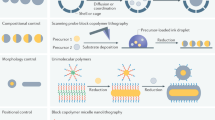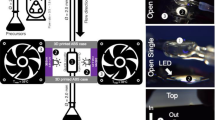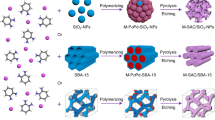Abstract
The batch synthesis of inorganic clusters can be both time consuming and limited by a lack of reproducibility. Flow-system approaches, now common in organic synthesis, have not been utilized widely for the synthesis of clusters. Herein we combine an automated flow process with multiple batch crystallizations for the screening and scale up of syntheses of polyoxometalates and manganese-based single-molecule magnets. Scale up of the synthesis of these architectures was achieved by programming a multiple-pump reactor system to vary reaction conditions sequentially, and thus explore a larger parameter space in a shorter time than conventionally possible. Also, the potential for using the array as a discovery tool is demonstrated. Successful conditions for product isolation were identified easily from the array of reactions, and a direct route to ‘scale up’ was then immediately available simply by continuous application of these flow conditions. In all cases, large quantities of phase-pure material were obtained and the time taken for the discovery, repetition and scale up decreased.
This is a preview of subscription content, access via your institution
Access options
Subscribe to this journal
Receive 12 print issues and online access
$259.00 per year
only $21.58 per issue
Buy this article
- Purchase on Springer Link
- Instant access to full article PDF
Prices may be subject to local taxes which are calculated during checkout






Similar content being viewed by others
References
Luis, S. V. & Garcia-Verdugo, E. Chemical Reactions and Processes under Flow Conditions (Royal Society of Chemistry, 2010).
Seeberger, P. H. Organic synthesis: scavengers in full flow. Nature Chem. 1, 258–260 (2009).
Wegner, J., Ceylan, S. & Kirschning, A. Ten key issues in modern flow chemistry. Chem. Commun. 47, 4583–4592 (2011).
Hartman, R. L., McMullen, J. P. & Jensen, K. F. Deciding whether to go with the flow: evaluating the merits of flow reactors for synthesis. Angew. Chem. Int. Ed. 50, 7502–7519 (2011).
Abou-Hassan, A., Sandre, O. & Cabuil, V. Microfluidics in inorganic chemistry. Angew. Chem. Int. Ed. 49, 6268–6286 (2010).
Long, D-L., Burkholder, E. & Cronin, L. Polyoxometalate clusters, nanostructures and materials: from self assembly to designer materials and devices. Chem. Soc. Rev. 36, 105–121 (2007).
Long, D-L., Tsunashima, R. & Cronin, L. Polyoxometalates: building blocks for functional nanoscale systems. Angew. Chem. Int. Ed. 49, 1736–1758 (2010).
Evangelisti, M. & Brechin, E. K. Recipes for enhanced molecular cooling. Dalton Trans. 39, 4672–4676 (2010).
Inglis, R., Milios, C. J., Jones, L. F., Piligkos, S. & Brechin, E. K. Twisted molecular magnets. Chem. Commun. 48, 181–190 (2012).
Moushi, E. E. et al. Inducing single-molecule magnetism in a family of loop-of-loops aggregates: heterometallic Mn40Na4 clusters and the homometallic Mn44 analogue. J. Am. Chem. Soc. 132, 16146–16155 (2010).
Murrie, M. Cobalt(II) single-molecule magnets. Chem. Soc. Rev. 39, 1986–1995 (2010).
Wang, X-Y., Avendano, C. & Dunbar, K. R. Molecular magnetic materials based on 4d and 5d transition metals. Chem. Soc. Rev. 40, 3213–3238 (2011).
Krebs, B., Stiller, S., Tytko, K. H. & Mehmke, J. Structure and bonding in the high-molecular-weight isopolymolybdate ion, (Mo36O112(H2O)16)8− – the crystal structure of Na8(Mo36O112(H2O)16)·58H2O. Eur. J. Solid State Inorg. Chem. 28, 883–903 (1991).
Müller, A. et al. Rapid and simple isolation of the crystalline molybdenum-blue compounds with discrete and linked nanosized ring-shaped anions: Na15[MoVI126MoV28O462H14(H2O)70]0.5[MoVI124MoV28O457H14(H2O)68]0.5·ca.400H2O and Na22[MoVI118MoV28O442H14(H2O)58]·ca.250H2O. Z. Anorg. Allg. Chem. 625, 1187–1192 (1999).
Müller, A., Krickemeyer, E., Bögge, H., Schmidtmann, M. & Peters, F. Organizational forms of matter: an inorganic super fullerene and Keplerate based on molybdenum oxide. Angew. Chem. Int. Ed. 37, 3359–3363 (1998).
Müller, A., Beckmann, E., Bögge, H., Schmidtmann, M. & Dress, A. Inorganic chemistry goes protein size: a Mo368 nano-hedgehog initiating nanochemistry by symmetry breaking. Angew. Chem. Int. Ed. 41, 1162–1167 (2002).
Inglis, R. et al. Enhancing SMM properties via axial distortion of MnIII3 clusters. Chem. Commun. 45, 5924–5926 (2008).
Inglis, R. et al. Twisting, bending, stretching: strategies for making ferromagnetic [MnIII3] triangles. Dalton Trans. 42, 9157–9168 (2009).
Inglis, R. et al. Attempting to understand (and control) the relationship between structure and magnetism in an extended family of Mn6 single-molecule magnets. Dalton Trans. 18, 3403–3412 (2009).
Kozoni, C., Siczek, M., Lis, T., Brechin, E. K. & Milios, C. J. The first amino acid manganese cluster: a [MnIV2MnIII3] DL-valine cage. Dalton Trans. 42, 9117–9119 (2009).
Levenspiel, O. Chemical Reaction Engineering (John Wiley, 1999).
Müller, A. et al. [Mo154(NO)14O420(OH)28(H2O)70](25±5)−: a water-soluble big wheel with more than 700 atoms and a relative molecular mass of about 24000. Angew. Chem. Int. Ed. Engl. 34, 2122–2124 (1995).
Müller, A., Meyer, J., Krickemeyer, E. & Diemann, E. Molybdenum blue: a 200 year old mystery unveiled. Angew. Chem. Int. Ed. Engl. 35, 1206–1208 (1996).
Müller, A. et al. Thirty electrons ‘trapped’ in a spherical matrix: a molybdenum oxide-based nanostructured Keplerate reduced by 36 electrons. Angew. Chem. Int. Ed. 39, 1614–1616 (2000).
Müller, A. et al. Drawing small cations into highly charged porous nanocontainers reveals ‘water’ assembly and related interaction problems. Angew. Chem. Int. Ed. 42, 2085–2090 (2003).
Henry, M., Bögge, H., Diemann, E. & Müller, A. Chameleon water: assemblies confined in nanocapsules. J. Mol. Liq. 118, 155–162 (2005).
Rittner, W., Müller, A., Neumann, A., Bafher, W. & Sharma, R. C. Generation of the triangulo-group MoV-ETA-S2 in the condensation of [MoVIO2S2]2 to [MoVO2S2]2 . Angew. Chem. Int. Ed. Engl. 17, 530–531 (1979).
Cadot, E., Salignac, B., Halut, S. & Sécheresse, F. [Mo12S12O12(OH)12(H2O)6]: a cyclic molecular cluster based on the [MO2S2O2]2+ building block. Angew. Chem. Int. Ed. 37, 611–612 (1998).
Salignac, B., Riedel, S., Dolbecq, A., Sécheresse, F. & Cadot, E. ‘Wheeling templates’ in molecular oxothiomolybdate rings: syntheses, structures, and dynamics J. Am. Chem. Soc. 122, 10381–10389 (2000).
Cadot, E., Salignac, B., Marrot, J., Dolbecq, A. & Sécheresse, F. [Mo10S10O10(OH)10(H2O)5]: a novel decameric molecular ring showing supramolecular properties. Chem. Commun. 261–262 (2000).
Cadot, E., Salignac, B., Halut, S. & Sécheresse, F. [Mo12S12O12(OH)12(H2O)6]: a cyclic molecular cluster based on the [Mo2S2O2]2+ building block. Angew. Chem. Int. Ed. 37, 611–613 (1998).
Bogani, L. & Wernsdorfer, W. Molecular spintronics using single-molecule magnets. Nature Mater. 7, 179–186 (2008).
Evangelisti, M., Luis, F., de Jongh, L. J. & Affronte, M. Magnetothermal properties of molecule-based materials. J. Mater. Chem. 16, 2534–2549 (2006).
Zheng, Y-Z., Evangelisti, M., Tuna, F. & Winpenny, R. E. P. Co–Ln mixed-metal phosphonate grids and cages as molecular magnetic refrigerants. J. Am. Chem. Soc. 134, 1057–1065 (2012).
Leuenberger, M. N. & Loss, D. Quantum computing in molecular magnets. Nature 410, 789–793 (2001).
Lehmann, J., Gaita-Arino, A., Coronado, E. & Loss, D. Spin qubits with electrically gated polyoxometalate molecules. Nature Nanotechnol. 2, 312–317 (2007).
Karotsis, G. et al. [MnIII4LnIII4] calix[4]arene clusters as enhanced magnetic coolers and molecular magnets. J. Am. Chem. Soc. 132, 12983–12990 (2010).
Lange, H. et al. A breakthrough method for the accurate addition of reagents in multi-step segmented flow processing. Chem. Sci. 2, 765–769 (2011).
McMullen, J. P., Stone, M. T., Buchwald, S. L. & Jensen, K. F. An integrated microreactor system for self-optimization of a heck reaction: from micro- to mesoscale flow systems. Angew. Chem. Int. Ed. 49, 7076–7080 (2010).
Parrott, A. J., Bourne, R. A., Akien, G. R., Irvine, D. J. & Poliakoff, M. Self-optimizing continuous reactions in supercritical carbon dioxide. Angew. Chem. Int. Ed. 50, 3788–3792 (2011).
Rasheed, M. & Wirth, T. Intelligent microflow: development of self-optimizing reaction systems. Angew. Chem. Int. Ed. 50, 357–358 (2011).
Miras, H. N. et al. Unveiling the transient template in the self assembly of a molecular oxide nano-wheel. Science 327, 72–74 (2010).
Miras, H. N., Richmond, C. J., Long, D-L. & Cronin, L. Solution-phase monitoring of the structural evolution of a molybdenum blue nanoring. J. Am. Chem. Soc. 134, 3816–3824 (2012).
Acknowledgements
This work was supported by the Engineering and Physical Sciences Research Council, WestCHEM, The Leverhulme Trust and the University of Glasgow. L.C. thanks the Royal Society/Wolfson Foundation for a merit award. H.N.M. thanks the Royal Society of Edinburgh and Marie Curie Actions for financial support. We also thank J. McIver for technical assistance in assembling the electronics and flow kit.
Author information
Authors and Affiliations
Contributions
L.C. conceived the overall idea and designed the flow system, including the control concept. L.C. and C.J.R. designed experiments, analysed data, prepared the figures and co-wrote the manuscript. H.N.M. helped with some of the flow-system design, provided advice and assisted with crystallography. A.R. applied and corroborated the syntheses and compound analysis. D.L. solved and checked the crystallographic data. C.J.R. and L.P. co-wrote the software interface used for the programmed pump control and C.M. helped in the verification of the interface. E.K.B and R.I. provided help with the synthesis of the Mn-based complexes. V.S. provided help with chemical engineering aspects and H.Z. helped with the synthesis of compound 6.
Corresponding author
Ethics declarations
Competing interests
The authors declare no competing financial interests.
Supplementary information
Supplementary information
Supplementary information (PDF 1113 kb)
Supplementary information
Crystallographic data for compound 4 (CIF 32 kb)
Supplementary information
Crystallographic data for compound 6 (CIF 102 kb)
Supplementary information
Crystallographic data for compound 9 (CIF 54 kb)
Supplementary information
Script for pumping sequences (TXT 37 kb)
Supplementary information
Script for pumping sequence for Mo96 cluster (TXT 8 kb)
Rights and permissions
About this article
Cite this article
Richmond, C., Miras, H., de la Oliva, A. et al. A flow-system array for the discovery and scale up of inorganic clusters. Nature Chem 4, 1037–1043 (2012). https://doi.org/10.1038/nchem.1489
Received:
Accepted:
Published:
Issue Date:
DOI: https://doi.org/10.1038/nchem.1489
This article is cited by
-
How to explore chemical space using algorithms and automation
Nature Reviews Chemistry (2019)
-
An autonomous organic reaction search engine for chemical reactivity
Nature Communications (2017)
-
Discovery of gigantic molecular nanostructures using a flow reaction array as a search engine
Nature Communications (2014)
-
Linking the Inner Isophtalate Guests Within Hexadeca-Oxothiomolybdenum Cyclic Arrangements. Synthesis, Structures and Stability in Solution
Journal of Cluster Science (2014)
-
Continuous flow synthesis and characterization of tailor-made bare gold nanoparticles for use in SERS
Microchimica Acta (2014)



